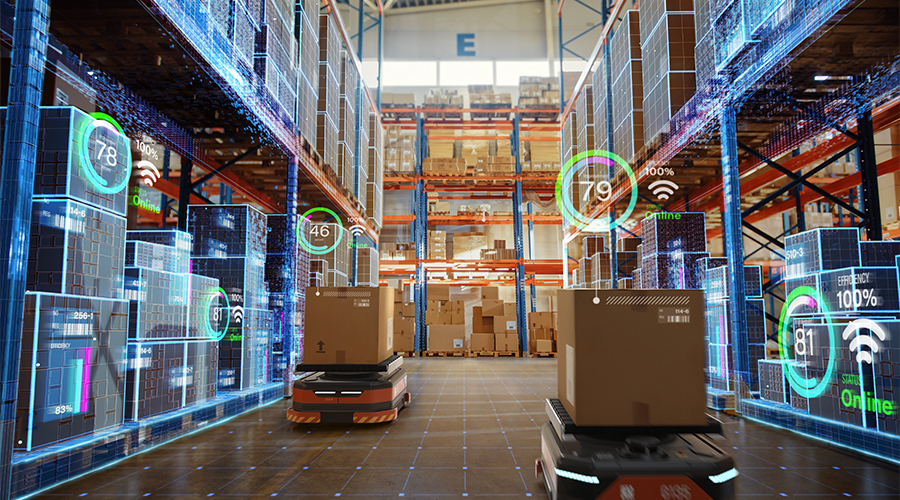
Shipping Predictors for Retail
What are shipping predictors?
E-commerce is expected to make up 25% of all global retail sales by 2025. This reminds retailers that shipping and shipment ETAs, are critical to maintaining loyal customers. Consumers want to feel confident about expecting their purchases to arrive on time. As a common theme on our blog, we want to outline the potential that AI can bring to shipping predictors to offer reliable and accurate shipping ETAs. There are a myriad of variables that AI takes into consideration when calculating accurate predictions: average speed of the vehicle, distance, traffic, and even weather conditions. Machine Learning (ML) adds another layer of technical support because the technology can actually learn patterns from previous shipments. For instance, a ML model learns that a vehicle of a certain size travels at a certain average speed depending on specific weather conditions and will use this learning to assess another shipping vehicle in order to accurately predict ETAs.
How can retailers benefit from shipping predictors?
API compatibility
Shipping predictors are often linked to Application Programming Interfaces, APIs, which are used to bridge an online retailer with tracking functionalities. Shipping APIs, specifically, allow for shipping services to be embedded within a business’ website. Various shipping APIs already have shipping predictor capabilities, which truly benefits everyone involved (e.g. customers, supply chain teams, etc.) At Iterate.ai, we know that using low-code provides a quicker, more efficient and seamless API integration experience. Retailers need an application that is able to connect to their website, APIs, and other necessary platforms in order to provide quality shipping experiences for customers. Using our low-code platform, Interplay®, we are able to connect to both external shipping brokerage APIs and internal product and inventory catalogs in order to provide instantaneous shipping calculations for customers who are online shopping. Our intuitive drag-and-drop low-code platform allows enterprises to overcome any obstacles related to shipping, transportation, or logistics, and focus on providing the customer experience they want to provide.
Customer Experience
We know that customers want two things: to know when their item is arriving, and how they can check for any shipping updates. Customers want to know exactly when to expect their package; they don’t want a date range, they want to know the exact day and sometimes even the exact time. Using predictive shipping technology, sharing ETAs with customers helps manage and meet their expectations, creating a positive experience for them. Taking it one step further, combining the power of shipping predictors with consistent communication about shipment status updates provides the best customer experience for businesses’ end-customers. This can look like sending automatic SMS updates, or emailing customers every few days based on the status of their item. Customers truly prefer companies that provide both of these options and it makes sense because offering these services builds trust and confidence between customers and brands.
What is the future of predictive shipping?
Using AI for shipping predictions has already hit the market and changed customers’ expectations when purchasing from online retailers. Large shipping companies have already adopted AI algorithms to forecast demand and provide accurate ETAs for customers. AI saves time for logistics operations teams, for example, and gives them more space to focus on improving customer service.
Gartner predicts that by 2026, more than 75% of supply chain organizations will offer AI capabilities for their shipping applications. AI and ML automates menial tasks, allowing for more time to be dedicated to scaling supply chain teams and making strategic business decisions, and of course, improving the customer experience. The future of shipping predictors involves not only predictive AI, but notably, prescriptive AI. The latter allows for the technology to make decisions on behalf of the company in order to provide the most desired outcome. There are already organizations that are slowly starting to adopt prescriptive AI, partnering with startups who create this technology. Portcast, for example, is a Singaporean startup that is building the next generation of digitalization for shipping companies by offering prescriptive AI that can enable automated route changes for shipment vehicles (in this case, through ocean shipping.)
As AI and ML continue to advance for shipping industries, retailers must be vigilant with how they can leverage this technology to their advantage. Customers are already adapting to these changes and their expectations are becoming more demanding for retailers. At Iterate.ai, we know how to make recommendations for large corporations looking to connect with startups who can provide the best technology necessary. We also offer our low-code platform, Inteplay, that can connect to various APIs that directly improve the shipping experience for both retailers and customers. For more information, please contact us here.
Our Innovation Blog
Stay ahead of trends with insights from iterate.ai experts and advisors